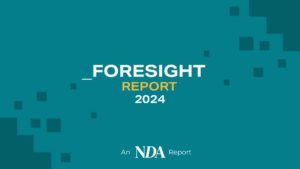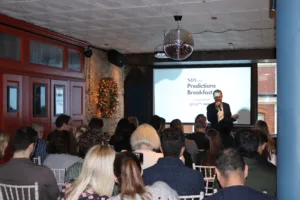NDA recently hosted the 2022 Predictions Lunch, in association with Xandr, bringing together representatives from the likes of Heineken, Deliveroo, Channel 4, Samsung Ads, Nestlé, Spark Foundry, Starcom, and many more, for an afternoon of good food and conversation dedicated to the insight and inspiration collected throughout Q1 on the Xandr predictions hub.
Over the past few years, we’ve seen consumer behaviours evolve rapidly and, alongside the advancement of technology, reshaping the world we now live in. This has brought about a number of big talking points.
It was these themes and trends that were the focus of discussion at the recent Predictions Lunch we hosted in partnership with Xandr. So, what interesting developments should we be looking out for in the rest of the year and beyond?
Challenging times
The consensus around the room was that challenges have evolved ‘beyond identity,’ and beyond what happens after the demise of third-party cookies. Top of mind is measurement, now more important than ever as advertisers are increasingly looking to track their media spend more accurately, and see where they’re getting true incremental value in order to fully understand the return of investment.
The measurement challenge is taken a step further when you consider that digital plays a part in most media channels nowadays, making up 79% of total ad spend across the UK. Digital has also opened the door to more granular reporting, a popular aspect of digital advertising among many CMOs. Today, the challenge comes in the need for omnichannel measurement.
Brands are looking to reach their audience across multiple devices, platforms and formats and the possibility of comparing effectiveness across multiple areas is highly appealing. The difficulty is that these environments are vastly different. Programmatic display is years ahead of programmatic broadcast, for example. As such, the industry has yet to agree upon a cross-channel measurement standard that would enable more accurate measurement and reporting across environments, and the ability to bring together segments of data from across these channels. The question is whether this is even possible?
A post-cookie world
When it comes to life after third-party cookies, many solutions already exist. The problem is identifying the right ones to suit your business. That, in itself, is a challenge, but it also presents a great opportunity for brands to differentiate.
There is a huge opportunity to leverage your available first-, second-, and third-party data to ensure that your advertising, and communications continue to engage with consumers at a level we’ve become accustomed to with the third-party cookie.
Most savvy advertisers will be seeking out different partners, depending on the direction they are looking to explore, aligning themselves with those across the industry who will help them achieve their goals. This makes it a really exciting time, because rival businesses will each have different setups, and this will drive competition.
An eye on the supply
There’s an increased importance in knowing where your media spend is going. There’s a desire to diversify media plans, and support more independent news outlets that are focused on a wider range of demographics and niches. This is vitally important, particularly with all that’s happened in the past few years. Journalism is the lifeblood of democracy, providing unbiased, reliable sources for current affairs updates. Supporting and funding real journalism benefits everybody. Without it, we are limited to the confines of walled gardens, where content is user generated and often not fact-checked at all.
The breadth of media outlets on the open internet can also give advertisers the opportunity to differentiate from their competitors by identifying different publications to deliver ads on. This means there’s an opportunity to outperform your competitors without having to outspend them, as you would have to in a walled garden. Furthermore, there’s a far higher level of control and transparency that can be achieved by advertisers. Direct relationships between the buy- and sell-side will be incredibly important going forward, to continue to power the open internet that we know and enjoy today.
Retail therapy
The need to collaborate to ensure the future of digital advertising is also clear in the growing buzz around retail media. Retailers are innovating in order to open up their digital platforms to external brand platforms, underpinned by the retailers’ first-party relationships with their consumers. This type of collaboration will ensure the development of a better marketplace, with better opportunities for quality advertising that drives value for consumers, and provides activation and measurement capabilities for brands.
The future is bright
The room was abuzz with conversation in what was one of the first in-person events of the last two years for many of the attendees. There was an air of excitement of what’s to come and an understanding that, while challenges would need to be overcome, the digital advertising industry is moving in the right direction. At the heart of this move forward is partnerships and on this bright sunny day in central London, many of those were forged.
Watch more from our industry experts here.









